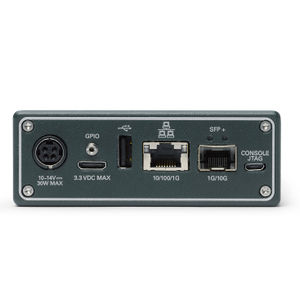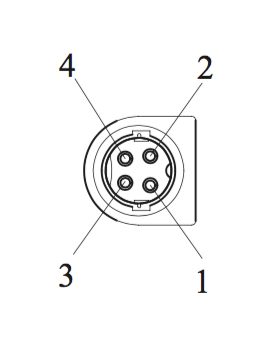E320
Contents
- 1 Device Overview
- 2 Key Features
- 3 RF Specifications
- 4 Hardware Specifications
- 5 Physical Specifications
- 6 Environmental Specifications
- 7 Schematics
- 8 GPSDO
- 9 Frontend Specifications
- 10 Interfaces and Connectivity
- 11 Guidance on SFP+ Adapters for Fiber Connectivity on USRP E320
- 12 Guidance on 10Gb SFP+ to RJ45 Adapters
- 13 Certifications
- 14 Certificate of Volatility
Device Overview
The USRP E320 brings performance to embedded software defined radios by offering four times more FPGA resources compared to the USRP E31x devices. The USRP E320 also introduces improvements in streaming, synchronization, integration, fault-recovery, and remote management capability. This field deployable SDR continues to use the flexible 2x2 MIMO AD9361 transceiver from Analog Devices, which covers frequencies from 70 MHz – 6 GHz and provides up to 56 MHz of instantaneous bandwidth.
Key Features
E320
|
RF Specifications
RF Performance
- Power Output >10dBm
- IIP3 (@ typical NF) -20dBm
- Typical Receive Noise Figure <8dB
Input Power Levels
- The maximum input power for the E320 is -15 dBm.
Hardware Specifications
- Ettus Research recommends to always use the latest stable version of UHD
- UHD version on the host computer must match what is running on the E320
E320
- Current Hardware Revision: 1
- Minimum version of UHD required: 3.14.0.0
Physical Specifications
Dimensions
E320 board-only with heatsink
- 173 x 100 x 36 mm
E320 Full enclosure
- 175 x 106 x 38 mm
Weight
E320 board-only with heatsink
- 0.16 kg
E320 Full enclosure
- 0.86 kg
Drawings
E320
E320 Enclosure
CAD/STP Models
E320
E320 Enclosure
Environmental Specifications
Operating Temperature Range
- 0-45 °C
Non-Operating Temperature Range
- -40-85 °C
Operating Humidity Range
- 10% to 90% non-condensing
Non-Operating Humidity Range
- 5% to 95% non-condensing
Schematics
- E320: File:Neon Public.pdf
GPSDO
- Support GPSDO NMEA Strings
Sensors
You can query the lock status with the gps_locked sensor, as well as obtain raw NMEA sentences using the gps_gprmc, and gps_gpgga sensors. Location information can be parsed out of the gps_gpgga sensor by using gpsd or another NMEA parser.
Specifications
| Module Specifications | |
|---|---|
| 1 PPS Timing Accuracy from GPS receiver | <8ns to UTC RMS (1-Sigma) GPS Locked |
| Holdover Stability (1 week with GPS) | <±50us over 3 Hour Period @+25°C (No Motion, No Airflow) |
| 1 PPS Output | 3.3VDC CMOS |
| Serial Port | TTL Level, GPS NMEA Output with 1Hz or 5Hz update rate, Integrated into UHD |
| GPS Frequency | L1, C/A 1574MHz |
| GPS Antenna | Active (3V compatible) or Passive (0dB to +30dB gain) |
| GPS Receiver | 65 Channels, QZSS, SBAS WAAS, EGNOS, MSAS capable
Supports Position and Hold over-determined clock mode |
| Sensitivity | Acquisition -148dBm, Tracking -165dBm |
| TTFF | Cold Start: <32 sec, Warm Start: 1 sec, Hot Start: 1 sec |
| ADEV | 10s: <7E-011
10Ks: <2E-012 (GPS Locked, 25°C, no motion, no airflow) |
| Warm Up Time / Stabilization Time | <10 min at +25C to 1E-09 Accuracy |
| Supply Voltage (Vdd) | 3.3V Single-Supply, +0.2V/-0.15V |
| Power Consumption | <0.16W |
| Operating Temperature | -10°C to +70°C |
| Storage Temperature | -45C to 85C |
| Oscillator Specifications (internal) | |||
|---|---|---|---|
| Frequency Output of low Phase Noise crystal | 20MHz CMOS 3Vpp | ||
| 20MHz Retrace | ±2E-08 After 1 Hour @ +25°C without GPS | ||
| RF Output Amplitude | 3Vpp CMOS | ||
| 20MHz Phase Jitter (100Hz to 10MHz) | <0.135ps rms | ||
| Frequency Stability Over Temperature (0°C to +60°C) | ±0.1ppm (internal TCXO without GPS) | ||
| Warm Up Time | < 1 min at +25C | ||
| Phase Noise at 20MHz | 1Hz | -65 dBc/Hz | |
| 10Hz | -97 dBc/Hz | ||
| 100Hz | -116 dBc/Hz | ||
| 1kHz | -136 dBc/Hz | ||
| 10kHz | <-148 dBc/Hz | ||
| 100 kHz | <-155 dBc/Hz | ||
Datasheet
- Spec Sheet: http://www.jackson-labs.com/assets/uploads/main/LTE-Lite_specsheet_20MHz.pdf
- User Manual: http://www.jackson-labs.com/assets/uploads/main/LTE-Lite.pdf
Frontend Specifications
Tuning
The RF frontend has individually tunable receive and transmit chains. Both transmit and receive can be used in a MIMO configuration. For the MIMO case, both receive frontends share the RX LO, and both transmit frontends share the TX LO. Each LO is tunable between 50 MHz and 6 GHz.
Gains
All frontends have individual analog gain controls. The receive frontends have 76 dB of available gain; and the transmit frontends have 89.8 dB of available gain. Gain settings are application specific, but it is recommended that users consider using at least half of the available gain to get reasonable dynamic range.
Interfaces and Connectivity
- RJ45 (1 GbE)
- SFP+ (1/10 GbE, Aurora)
- Type A USB Host
- Micro-USB (serial console, JTAG)
- GPIO
- Integrated GPSDO
- 9-axis IMU
Front Panel
Rear Panel
Power Connector
Model: PDP-40 by CUI Inc.
Power plug connectors for custom power harnesses can be purchased here: https://www.digikey.com/products/en?KeyWords=CP-7340-ND&WT.z_cid=sp_102_buynow
Assembly instructions: Media:pdp-40.pdf
Pin Detail
- Pins #1 / #2: 12v
- Pins #3 / #4: Ground
Guidance on SFP+ Adapters for Fiber Connectivity on USRP E320
Ettus Research currently offers direct-connect, copper cabling accessories for the USRP E320. However, it is also possible to use multi-mode fiber instead of copper connections for these devices. In this section, we will provide general guidance on the types of fiber adapters and cables that can be used with these products.
The USRP E320 USRP is compatible with most brands of SFP+ fiber adapters. In some cases, other equipment in the systems such as 1/10 Gigabit Ethernet switches are only compatible with specific brands of SFP+ adapters and cables. As a general rule, we recommend checking compatibility with the switches and network cards in your system before purchasing an adapter.
Ettus Research does test the USRP E320 USRP devices with our 10 Gigabit Ethernet Connectivity Kit and a Blade Networks G8124 1/10 GigE switch. Here are is a list of known-good cables and adapters.
Ettus Research has only tested multi-mode fiber accessories.
Known-Good Adapters
Known-Good Cables
Guidance on 10Gb SFP+ to RJ45 Adapters
Many new motherboards come equipped with an onboard 10Gb RJ45 NIC. It is possible to use a SFP+ to RJ45 adapter and operate at 10Gb speeds using a Cat6/7 Ethernet cables.
Ettus Research has tested the adapters linked below.
Known-Good Adapters
Certifications
RoHS
As of December 1st, 2010 all Ettus Research products are RoHS compliant unless otherwise noted. More information can be found at http://ettus.com/legal/rohs-information
China RoHS
Management Methods for Controlling Pollution Caused by Electronic Information Products Regulation
Chinese Customers
National Instruments is in compliance with the Chinese policy on the Restriction of Hazardous Substances (RoHS) used in Electronic Information Products. For more information about the National Instruments China RoHS compliance, visit ni.com/environment/rohs_china.
Certificate of Volatility
Found on the NI Product Certifications lookup tool here.





